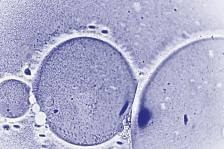How to Think About Small Numbers, Part 1
How can you understand the sizes of numbers that are unimaginably minuscule? By shrinking yourself down to an equally unimaginable tiny size! How does that help? Keep on reading to find out.
Jason Marshall, PhD
Listen
How to Think About Small Numbers, Part 1

But even if we’ve come to terms with the existence of these really big and really small numbers, we’re just not very good at thinking about how big or how small they actually are. After all, ridiculously big and small numbers aren’t something we routinely deal with in everyday life, so why should we be able to easily understand how big or small they are? In truth, we shouldn’t! But that doesn’t mean we can’t.
So, how can we develop our intuition and come to an understanding of these numbers? That’s exactly what we’re going to be thinking about today.
How to Think About Small Numbers
We’ve talked before about how to think about astronomically large numbers, but we’ve never talked about how to think about numbers going in the opposite direction—toward the really tiny guys. Since numbers by themselves are rather abstract little critters, and since it’s tough to picture abstract things in our heads, we’re going to think about small numbers in a more concrete fashion by contemplating extremely small distances.
But not just any old random distances, we’re going on an imaginary journey in which we continually shrink ourselves down to see what we can find at smaller and smaller distance-scales within an apparently boring puddle of water. Although, instead of imagining that we get smaller and smaller, we’re going to imagine that the puddle of water gets bigger and bigger. Why is that? Because I find that it’s easier to picture things that are bigger than us rather than things that are smaller than us. After all, it’s not too hard to think about the size of a football field, or a city, or a country, or even a planet. But it is hard to think about things that are proportionally much smaller than ourselves, don’t you think?
So, let’s start our trek into that puddle of water and see what we can find. And, in the process, let’s see how to think about all of those tiny numbers.
Millionths, Micrometers, and Microbes
To begin with, imagine staring at a puddle of water that’s about 1 meter across. What do you see? Assuming it’s clean water, you probably just see…well…water. But now imagine zooming in on that puddle so that it stretches out to be 1,000 times its original size. At this level of magnification, the original 1 meter wide puddle has become a 1 kilometer (or about 0.6 miles) wide lake. And, if you think about it, you’ll see that something that is 1,000 times smaller than the original puddle will appear to be the size of the original puddle in this 1 kilometer wide lake. In other words, an object that’s actually 1 millimeter in size (which is 1/1,000 of a meter) will appear to be 1 meter in size in our lake.

Our once 1 meter puddle…becomes a 1,000 kilometer wide sea.
Zooming in another 1,000 times, our once 1 meter wide puddle, which became a 1 kilometer wide lake, becomes a 1,000 km wide sea that’s about one-third as large as the Mediterranean! We’ve now zoomed in a total of 1,000 x 1,000 = 1,000,000 times, which means that something that is actually one-millionth of a meter in length—a distance known as a micrometer (which all the cool kids call a “micron”)—will now appear to you (a person swimming in that 1,000 kilometer wide sea) to be 1 meter across.
So, what would the water look like at this level of magnification? A lot more interesting. Because we have now entered the realm of the microbe—aka, bacteria, paramecium, and all those other fascinating little creatures, many of whom tend to be a few to a few tens of microns in size. In other words, if you were swimming in that 1,000 kilometer wide sea, you’d see lots and lots of meter-sized creatures swimming right there with you!
Billionths, Trillionths, and Even Smaller Numbers
Just to be clear, these microbes are roughly a millionth of a meter across in real life. And in order to find them in a 1 meter wide puddle, we’ve seen that we need to magnify that puddle until it’s as big as an entire sea. Kind of crazy, right?
So that’s what a millionth of a meter looks like. And while 1/1,000,000 is indeed a pretty small number, next time we’re going to see that we can go a lot smaller. In fact, we’re going to zoom in on our puddle of water another 1,000 times, and then another 1,000 times, and on and on until we just can’t take the insanity of these tiny numbers any more.
At each of these levels of magnification, we’ll discover that a drop of water isn’t just a drop of water. And we’ll discover that with just a little thought and imagination, we really can come to an understanding of the meaning of these nearly—but not quite—unimaginably small numbers.
Wrap Up
Okay, that’s all the math we have time for today.

For more fun with math, please check out my book, The Math Dude’s Quick and Dirty Guide to Algebra. And remember to become a fan of The Math Dude on Facebook, where you’ll find lots of great math posted throughout the week. If you’re on Twitter, please follow me there, too.
Until next time, this is Jason Marshall with The Math Dude’s Quick and Dirty Tips to Make Math Easier. Thanks for reading, math fans!
Atom and Under a Microscope images courtesy of Shutterstock.

